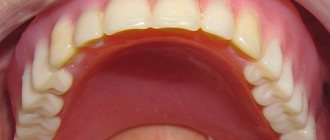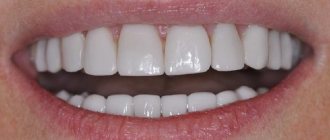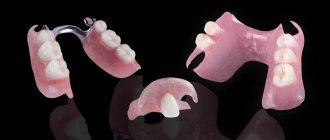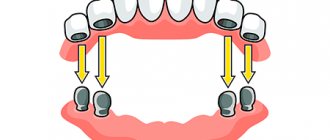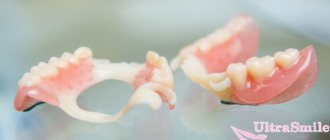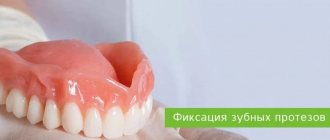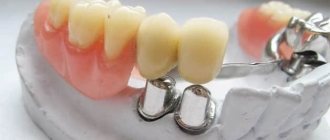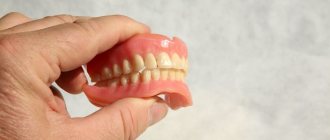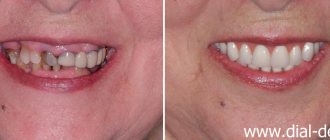Removable prosthetic structures made of ordinary plastic, which people used in the past, had two main disadvantages. This is not comfortable enough to use and the fixation in the oral cavity is unreliable. New generation dentures, which are offered by all modern dental clinics, do not have both disadvantages. These designs are made from more functional and safe materials, and also lack some bulky elements. Several types of such prostheses are used in orthopedic dentistry today.
Flexible orthopedic structures
An innovation in dental removable prosthetics has been the use of thermoplastics. Such materials include acry-free, nylon, polyamide. They make it possible to produce structures that are as close as possible in color and texture to the natural tissues of the oral cavity. Unlike standard acrylic prostheses, their counterparts made of thermoplastic materials have a flexible structure, that is, a certain degree of elasticity. All this led to such obvious advantages of these designs as:
- high precision fit to the gum;
- increased strength and resistance to breakage;
- relatively light weight;
- no allergic reactions when used;
- high aesthetics due to the natural appearance and the use of non-metallic clasps that are not noticeable to others.
Removable dentures made of thermoplastic materials: advantages and disadvantages
Dentures made of thermoplastic materials (including nylon) are divided into complete and partial. They are made of soft plastic and are highly elastic. Fastening of nylon dentures is carried out both using plastic clasps and due to the pliability of the material, which seems to envelop the gums. The first method is used when installing partial and microprostheses. The second is used for complete loss of teeth.
Removable nylon dentures can be either full or partial.
The main arguments in favor of prostheses made of thermoplastic materials:
- Possibility of installation for patients prone to allergic reactions to metals;
- aesthetics - removable dentures of this type are invisible in the mouth;
- no irritation or abrasions on the gums due to soft plastic;
- elasticity of the structure, which ensures the strength and reliability of the prosthesis;
- service life - up to 5-7 years.
The main disadvantage of dentures made of soft thermoplastic materials is the incorrect distribution of load when chewing food. In addition, in some cases, special glue or gel is required to securely fix the structure.
Sandwich dentures
This is one of the newest developments by Russian specialists. Such prostheses are made of a polymer material with a dense structure. They look like a row of teeth with two large hollow crowns that act as retainers. Thus, to install a sandwich denture, at least two teeth must remain in the jaw.
The advantages of such designs:
- no need to grind support units;
- aesthetic appearance, invisibility of fixing elements;
- comfortable use, easy adaptation period;
- simple and quick adjustment of the product;
- the ability to leave it in the mouth overnight.
Clasp removable denture: advantages and disadvantages
A clasp denture consists of artificial teeth, a plate base and a metal frame. The main elements of the latter are:
- a saddle-shaped part that carries a plate base with teeth attached to it;
- supporting and retaining elements - clasps, telescopic systems, etc.;
- connecting arches that provide fastening of the supporting-retaining and saddle-shaped parts of the prosthesis.
Clasp dentures are used for both partial and complete loss of teeth. In the first case, they are attached to preserved natural teeth; in the second, it is necessary to install titanium implants into the jaw bone tissue—by far the most popular.
This is what a partial clasp denture with locks looks like.
The main advantage of the clasp denture is its physiology, which ensures proper distribution of the chewing load. As for other advantages, they include:
- small area of the lamellar base;
- possibility of choosing fastening elements;
- strength and reliability;
- long service life;
- affordable price.
Now about the cons. These include the possibility of a metallic taste in the mouth. In addition, not all types of clasp dentures are suitable for installation in the visible part of the dentition; for example, when using a locking fastening, metal elements may be noticeable when speaking. However, these shortcomings are offset by the emergence of new materials and designs. Thus, the quadrotti prosthesis, although it is of the clasp type, does not have metal parts. And with the right choice of fixing elements, clasp dentures are quite aesthetic and invisible in the mouth.
Dentures on implants
These are orthopedic structures that do not rest on the gums directly, but on implants installed in the jaw. Such dentures are also made in the form of a large arch, have a base part and a number of analogue teeth. But the volume of the artificial gum is significantly reduced and the maxillary structures do not have a plate. Structures with supports “implanted” into the jaw are used for complete edentia, and they are considered the best way to treat it because:
- They “sit” stably on the implants, do not move or fall out.
- They do not require long, painful habituation.
- They do not change the taste of dishes, since the receptors are not blocked.
- They do not require regular correction, unlike conventional removable dentures.
A large selection of new generation designs makes it possible to restore lost teeth in the optimal way. The best means of prosthetics in a particular situation is determined by the dentist, but the final word may remain with the patient.
When is the use of thermoplastics justified?
Thermoplastic plates are a solution for those patients whose teeth cannot be ground and there are minor defects in the dentition. Due to the unique lightness and softness of the structures, thermoplastic dentures can be used even in patients with inflammation of the periodontal tissues.
In addition, this denture material does not cause tissue irritation (which is typical for acrylic structures), and prevents the development of inflammatory processes in the oral cavity, which often occur during the use of plastic structures.
This type of prosthesis does not require special care. To ensure long service life and maintain the aesthetic appearance of prostheses, you should use products such as Corega, Ultra Sonic Wallplast or ValClean. You can also use dental floss and regular soap. Every six months you should undergo a professional cleaning procedure, which is also carried out in our One to One clinic. Waiting for you!
Manufacturing, care and cost
The development of computer technology has made it possible to use software that makes it possible to automate most of the stages of prosthetics. The equipment used in dental laboratories guarantees the accuracy of finished structures and reduces the overall production time.
Regular care, which includes not only standard hygiene procedures, but also the use of special products, helps to increase the service life of products. It is recommended to avoid abrasive pastes, since structures made of nylon and polyurethane are highly sensitive to their effects. Professional cleaning is carried out every six months.
The cost of dental restoration services depends on the complexity of each specific case. Thus, the price for an arc thermoplastic prosthesis in the St. Petersburg clinic “MY ORT” starts from 45 thousand rubles.
Adaptation period and service life
The average duration of getting used to prostheses is 30 days. During this time, the patient learns to eat, talk and smile with new teeth.
However, sometimes the adaptation period can increase to 3 months. This may be due to the following factors:
- atrophy of the alveolar ridge of the jaw (if the patient spent a long time without teeth and their analogues);
- poor stability of the structure (may occur due to smoothing of the gum relief or due to a poorly manufactured prosthesis);
- individual characteristics of the patient’s dental system.
This is interesting: Rules for storing and caring for clasp dentures
In order to quickly get used to the removable structure, you need to wear it all day. Removing the prosthesis from the oral cavity increases the adaptation time. In addition, the patient should immediately accustom himself to performing all necessary hygienic procedures associated with the operation of the structure in order to avoid discomfort and inflammation.
In the first days of wearing a prosthesis, increased salivation and vomiting may occur. These factors are eliminated on their own, with the body becoming accustomed to the presence of a foreign object in the oral cavity.
When you start wearing a prosthesis, you should gradually increase the load on the masticatory apparatus - chew cut pieces of fruit, bread, and other foods. You should not give up solid food. At first, you should only avoid seeds, nuts and sticky foods (taffy, caramel, etc.).
Setting up the correct articulation also happens quite quickly. If the prosthesis is well fixed, the patient quickly begins to articulate at a normal pace.
To speed up the process, you should practice speaking out loud more and actively use your facial muscles.
Who is it suitable for?
QuattroTi prosthetics are indicated in the following cases:
- if several teeth are missing in the dentition;
- as a temporary option before implantation;
- after treatment for gingivitis or periodontitis;
- with low incisor height;
- if the patient has sensitive or weak gums;
- there is no possibility of installing a classic clasp prosthesis;
- if the patient’s activity is associated with the likelihood of jaw injury;
- when the patient does not want to grind down the supporting teeth to install crowns.
However, there are certain limitations. The number of remaining teeth must correspond to the possibilities of installing the Quadrotti clasp denture. In the lower jaw, 4 supporting teeth are sufficient, and in the upper jaw there should be at least 6 or 7. Moreover, they should be located on both sides of the jaw.
There are also certain requirements for preserved teeth. They should not be mobile; it is also important that at the end of the dentition at least 1 tooth on each side is preserved. If the dentition has end defects, Quadrotti dentures cannot be fixed well - they will fall out when speaking or while eating.
In addition, there are contraindications:
- the presence of chronic periodontitis or other inflammatory diseases;
- high tissue atrophy;
- complete edentia;
- deviations in the state of the nervous system.
Temporary contraindications include caries. After treatment with QuattroTi, prosthetics become possible.
Kinds
There are no specific orthopedic devices, the technology of use and names of which have been registered. QuattroTi prosthetic products are manufactured using a single method and using identical models prepared individually. But Quadrotti devices can still be classified in the following areas:
the number of missing teeth - there are both small dentures designed for 1-2 teeth, similar to butterfly dentures, and those designed for installation with multiple included defects, the size of which can reach an entire dental arch;
by the color of the material used to make the hooks - this indicator depends on the shape of the crowns and the location of the hooks themselves (naturally, the artificial teeth themselves are made in white, and the gums are made in pink);
by localization - since QuattroTi prosthetics is used for both the lower and upper jaws, these designs differ (in the absence of chewing teeth in the upper part, an additional bridge is created that connects the product in the lateral parts).
Advantages and disadvantages
The advantages of polymer products include:
- good aesthetics;
- the shape of the row is natural, the shade is selected in accordance with the whole teeth;
- tight fit;
- precision manufacturing;
- the presence of fissure-tubercle contact between artificial and natural units;
- reliability;
- there is no loosening of the supporting elements;
- high elasticity rates;
- affordable price.
The disadvantages include:
- strength is lower than that of metal ceramics or non-metallic products;
- diet correction is required, since under heavy load the arch can be broken;
- susceptibility to staining with food pigments.
Indications for installation
Clasp dentures on hooks are used in the following cases:
- in the absence of several teeth in a row;
- included defects (loss in different places of the jaw);
- end defects (no outer teeth);
- periodontal diseases and tooth mobility from this. The arc prosthesis splints and keeps them stationary;
- increased wear of crowns. The denture covers them, protecting them from further abrasion.
Many patients choose an arched prosthesis because they want to move away from the insufficiently comfortable plate one.
